A group of Japanese and Indian artists come together to paint the walls of a village school near Dahanu, with the aim of promoting education and learning through cultural exchange
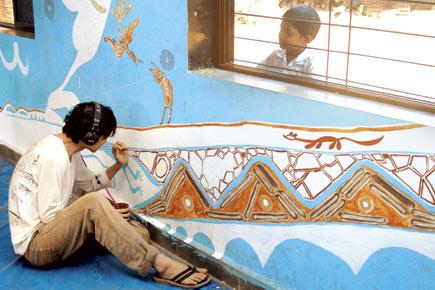
The picturesque village of Ganjad, almost 13 km from Dahanu Road station, is bustling with activity. The usually quiet Ashram School in the village is filled with laughter, with students who evidently prefer painting their classroom walls rather than studying.
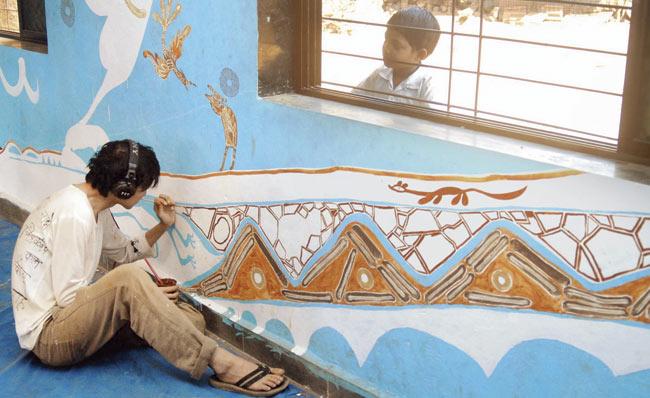
Artist Yusuke Asai with his Earth painting. Pics/Shadab Khan
ADVERTISEMENT
The school is currently hosting a group of Japanese and Indian artists, who have come together to paint the school walls. This is an initiative by The Wall Art Project, a non-profit organisation (NPO) from Japan, whose aim is to promote education and enhance a child’s creativity through painting.
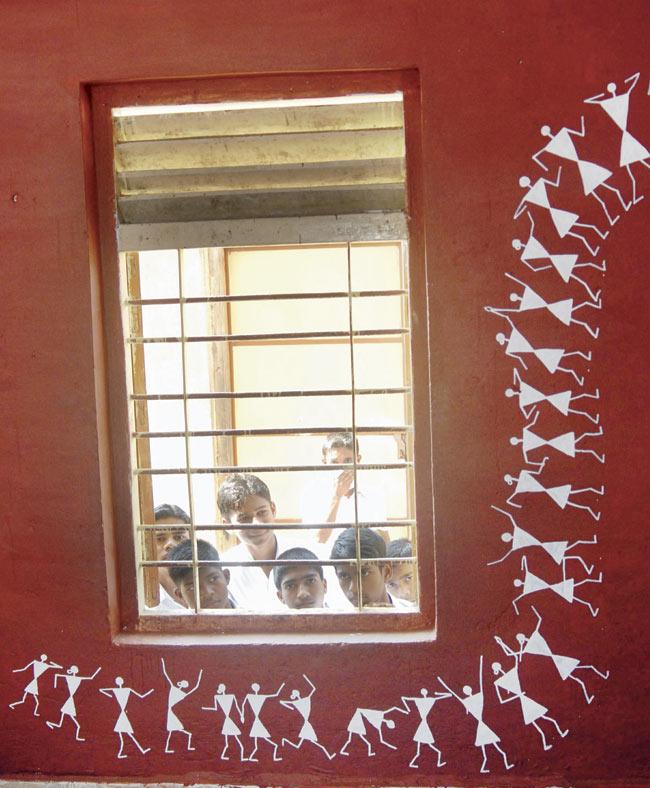
Students look as figures from Warli art are drawn on the walls
Project
For the project, the artists are painting five classrooms and a school corridor, using different techniques such as oil painting and traditional Gond painting from Madhya Pradesh (MP). Previously, the NPO had completed similar projects in Niranjan School in Bodh Gaya, Bihar and Jeevan Shikshan School in Ganjad.
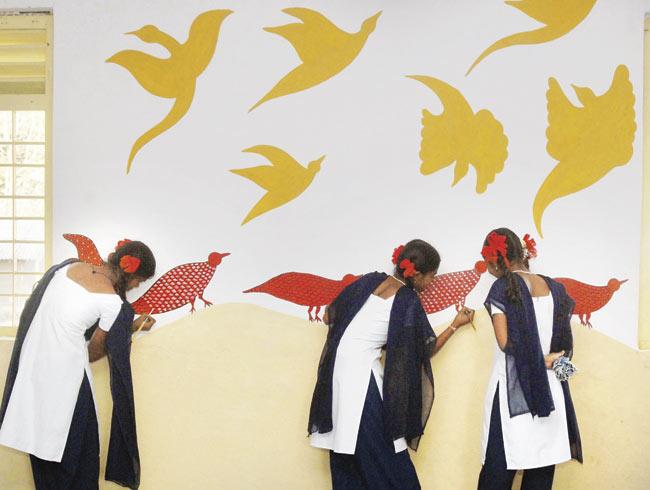
Students learn MP’s tribal Gond art, known for its bright colours
Internationally, they have done a similar project at Hozumi Primary School in Sakura city, Japan. The project at Ashram School, a primary and secondary school, started on January 30 and will be completed by February 15, with an exhibition to be held at the school.
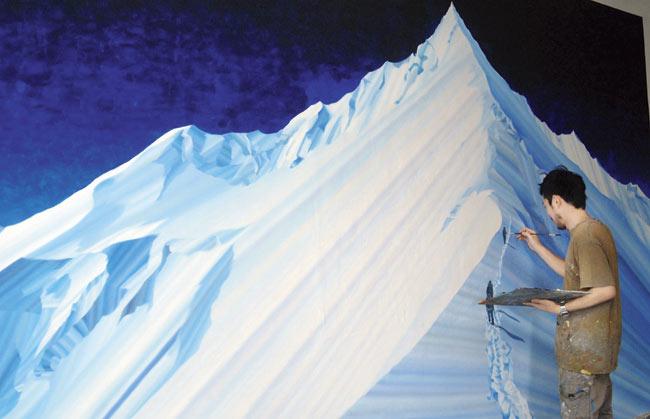
Akira Kamo and his oil painting on the wall
During this period, the artists have been conducting art workshops for the students and fostering cross-cultural exchange. Along with five Japanese and two Indian artists, are 45 volunteers from India and Japan who are painting the school walls. The project is funded by the Japan Foundation.

Ashram School teacher Bapu Chauhan
Aim
“The artists use the wall as their canvas,” says Kazunori Hamao, the Japanese-born director of the project — who speaks fluent Hindi. He feels that everything that cannot be said with words or numbers can be expressed through art. According to him, art has the potential to connect people and surpass boundaries. “Our first project in India was in Bodh Gaya, Bihar in 2010.
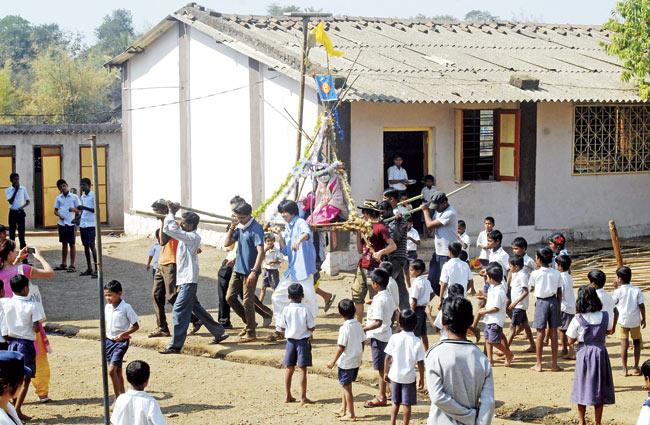
Artists introduce Mikoshi, a traditional Japanese vehicle used to transport deities, to the students
Initially a group of Japanese students had raised money towards a building for that school. But we felt that the school needs continuous support. And since we were all students, we could not afford to fund such large-scale initiatives. Hence we decided to give something more permanent. Since then, we have been painting school walls,” he says.

The group of artists and volunteers at the Ashram School
Wall Art Project’s chief director, Akiko Ookuni, who has been to Mumbai several times, says, “When you come to Mumbai, you notice a stark difference in the city, with beautiful glass skyscrapers towering over slum colonies. There is a huge gap in society. It is the same in Japan.
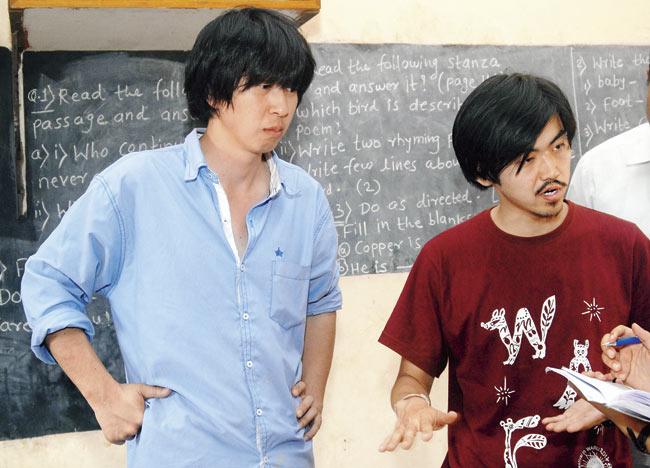
Artist Ichiro Endo (L) and director Kazunori Hamao (R)
But the difference between India and Japan is that people in India are working hard. There is a kind of energy in Mumbai, that cannot be explained, which attracts so many to it. But for this gap to decrease, we need to encourage education among everyone old or young, rich or poor.

Students and volunteers work together, cleaning the soil used for Earth painting
Culture
Hamao further explains that the aim of the project is to increase curiosity about art among children and enhance their creativity. Hamao says, “We have got wonderful artists, from Japan and India.
With people from different countries coming together, students are encouraged to take part in cultural exchange. So we are not only promoting art and education, but we are introducing a new culture and experiences to students, something which otherwise they might not have been able to receive.”
Rajesh Chaitya Vangad, a Warli artist, paints traditional motifs as well as scenes from contemporary society. Recently, Vangad had painted a wall in the Chhatrapati Shivaji International Airport’s new terminal building T2 in Mumbai. At the Ashram School, Vangad is using Warli art to paint a classroom.
He says, “This is a great opportunity for children to experience something new. They can understand the power of art. Though Warli painting has been in my family since generations, spreading the art is an enriching experience.”
Technique
Among the Japanese artists, Yusuke Asai has given new meaning to eco-friendly art. While many artists spend all their money on paint, Asai asks, “Why buy paint, when you can just dig it up?” Before starting the wall painting, Asai and his helpers walked across the village and collected cow dung and soil of different colours.
Later they cleaned the raw products and used it as paint, after mixing it with water. Engrossed in painting, Asai explains, “I call it Earth Art. The way soil and cow dung is used to create art, is very unpredictable. The only idea behind this kind of art is tell everyone that art does not have to be expensive to be beautiful.” He cheekily adds, “Who knew cow dung could be so beautiful!”
Kites
While most of the art is painted on the walls, the work of artist Ichiro Endo (34) is flown in the sky. He provides students with kites on which they can write or draw their dreams and aspirations, and all the kites are tied together to form a canopy.
With the artwork currently under process, Endo intends to collect the kites and form a canopy in the courtyard of the school. With Hamao playing translator, Endo says, “I started this Kite Project in 2009 and I have done it in Japan, UK, Thailand, Bhutan and China.
Through this project, I am connecting the dreams of people from different countries. I live in a yellow car called, ‘Go For Future’, where I have written people’s dreams. Just driving my car around encourages people to dream.”
Fun
While art is serious business for many, for the Ashram School students it is a creative excuse not to attend classes. Jitesh Ghatar, a Std IX student, says, “Though I know Warli painting, it is a different experience to paint on the class walls.”
At this, his classmate Jayesh Kevra, who was also painting with Ghatar, says, “Not only Warli, I have also started learning oil painting and Earth painting. Apart from art, we are learning so much about Japanese culture. This is the first time I have ever interacted with a foreigner, so it feels nice. Now I know a lot about their food and habits, and I can even say my name in Japanese.”
Academics
As artists and students from Ashram School are either busy painting the school walls or playing in the courtyard, secondary science teacher Bapu Chauhan watches over the kids closely. “Until the paintings are complete, we conduct the classes in batches, in one classroom on the ground floor. Even though this experience is important for children, we make it a point that they don’t skip studies.
Not only children from this school, but children from other schools are also coming over and interacting with the artists. Usually, the only exposure about other cultures kids get is through TV. This initiative will help a child grow and experience the world, without even travelling. And I enjoy talking to the artists. I am so glad the kids have this opportunity.”
Problem
Ganjad resident 22-year-old Mayur Vayeda, a Warli artist, says, “Though I am an artist, for this project I am a coordinator. In this project, not only the students but also the artists are introduced to a different culture. One of the major problems we face is the language.
While working, the artists show the students what to do, but during workshops, we always need a translator to help students understand. For this, Hamao helps with the English and Hindi translation and I help with the Marathi translation.” He adds, “At 22 years, I am finally experiencing Japanese culture. Here, the children are experiencing it at a very early age, and this will help them understand the world better. It will push them to dream and achieve big.”
Experience
On a lighter note, Ookuni says, “Everyone in Ganjad village is so helpful. Since we have arrived, from our stay to food, everything has been arranged by the locals. So far, I have learnt a little Hindi, and how to make typical Maharashtrian fish curry. I have never experienced village life like this before.
This exchange of cultures has not only helped the villagers to grow, but also the artists. We even arrange evening dances, where we teach the students a traditional Japanese dance and in return they teach us the Adivasi dance. This kind of exchange is very important for a child’s development.”
At the Ashram School, students, artists, teachers and locals keep themselves busy interacting with each other, without caring much about the hot February sun. The coming of people from two very different cultures and and forming bonds is a rare experience. While city schools often have international visitors, for a village school, this encounter helps in promoting education, introducing new cultures and encouraging to dream and achieve big.
 Subscribe today by clicking the link and stay updated with the latest news!" Click here!
Subscribe today by clicking the link and stay updated with the latest news!" Click here!







